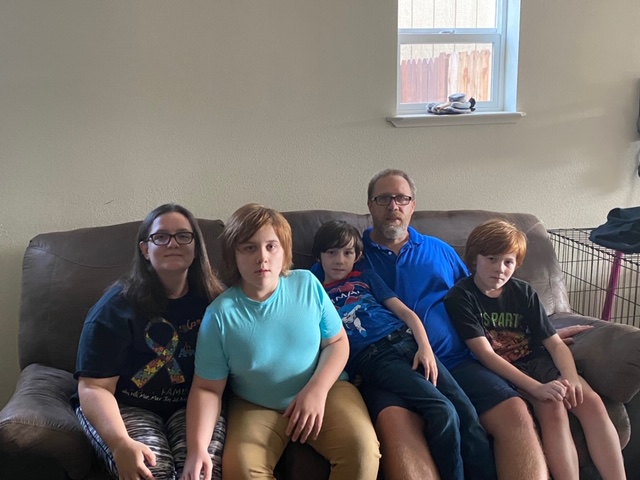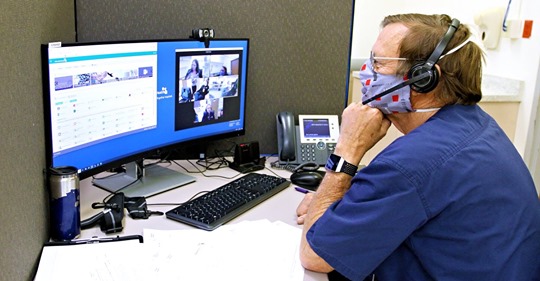MENDOCINO Co., 8/14/20 — Adventist Health, which now operates Mendocino County’s three hospitals, implemented a new “virtual hospital” program in May to expand capacity for potential COVID-19 surges, and to and increase patient safety during the ongoing pandemic. The program uses virtual technology to help medical professionals treat patients, while they can receive care in the comfort of their own homes.
Here’s more about the program in a press release from Adventist Health, which was also recently featured in an article about healthcare innovations during the pandemic in Time Magazine:
August 12, 2020 (Ukiah, CA) – Curtis Carlson, 49 from Ukiah, knew he was not the most patient of patients. So when he ended up in the emergency room for a kidney infection at Adventist Health Ukiah Valley, he was not looking forward to being in the hospital for a week, especially during a pandemic. Until he heard about AdventistHealth Hospital@Home, a virtual hospital that opened in May.
Carlson, who was Adventist Health’s first virtual hospital patient in Mendocino County, says it’s how a hospital experience should be. “This is my kind of hospital. I’ve always received great care here, but I just don’t like being in a hospital. I can never get comfortable, because no matter what I do, it’s not my home, not my bed.”
And when he shared the good news with his family that he was “bringing the hospital home,” Carlson knew he made the right decision. “The biggest part for me was when my 7-year old son gave me the biggest hug. He was so happy. He couldn’t believe I was home. I knew they were worried about me.”

Carlson says his experience was revolutionary and he is grateful to benefit from this innovative program that allows hospitals to add much needed capacity during the pandemic while improving the experience by caring for patients in their own homes through a virtual hospital.
Even as hospitals across the nation worked in no time to prepare to care for COVID-19 patients the challenge for everyone was adding bed capacity. “Adventist Health realized early on that we had to identify how we could grow and have the ability to take care of patients without building actual buildings, and it had to be done within a quick time frame,” explains Jason Wells, president for Adventist Health in Mendocino County.
The solution is a virtual hospital – a hospital with no beds or waiting rooms, through Adventist Health’s Hospital@Home, an innovative plan that supplements acute care capacity by using virtual technology to safely treat hundreds of additional patients in their homes. The first of its kind in California, Adventist Health Hospital@Home began admitting patients in May.
In collaboration with Medically Home® and Huron, Adventist Health Hospital@Home initiated three Medical Command Centers inside its current hospitals that can manage as many as 150 beds at homes in targeted service areas. Each service area has Rapid Response Teams that deploy to patients’ homes during scheduled visits when needed. These teams can accommodate a variety of clinical services, such as infusion, lab, pharmacy and mobile imaging, among others. In addition to Mendocino County, the virtual hospital currently serves Bakersfield, Clear Lake, Glendale, Hanford, Los Angeles and Simi Valley. Adventist Health Ukiah Valley operates one of the three command centers located across the state. As a rural community with limited resources, Mendocino County is an ideal area for this innovative program.
Wells describes the project as an important window into the future of healthcare. It is intended to answer many of the challenges of healthcare in rural communities, spurred by today’s immediate need to quickly expand hospital capacity. “For a rural community such as ours with limited beds, an additional 25 beds is significant. This innovative program will serve as another tool in our county’s continued fight against COVID-19 and beyond.”
After being admitted to his home, Carlson watched the Rapid Response Team set up his hospital. There was the same equipment you would expect in a typical hospital — a monitor, a blood pressure cuff, minus the hospital gown; and he could sleep in his own bed and recover with his family at his side.
“I’m not good with technology, but the team provided me with everything we needed,” he says. “The process was seamless, and they were very patient with teaching us how to use the equipment.”
Equipped with a tablet and devices such as a blood pressure monitor and scale that streamed his vital signs and other data from his home to the command center 20 miles away, Carlson and his team of providers and nurses managed his condition as he safely recovered at home. Throughout his five-day stay at the virtual hospital, physicians and nurses checked in on Carlson sometimes as many as four times a day, or as needed. A field nurse visited his home once a day to administer medications and perform nursing care. “At any time, if I had a question or needed to talk to a nurse, all I needed to do was press a button,” he says. “It felt good to know that even though I was home, I had a team of professionals behind me.”
Jill Bartolomie, MSN, RN, director for Adventist Health Hospital@Home for Mendocino County, shares that about 25 nurses and physicians monitor and connect with patients 24/7, answering questions about medications, signs, symptoms, medication side-effects, normal and abnormal findings and more.
“Our nurses have a direct connection with patients, much like they would if they were recovering in one of our brick-and-mortar departments,” Bartolomie explains. “If a patient needs something in the hospital, they press their call light and someone answers immediately. The same concept holds true for a patient being cared for at home. Especially during this pandemic, through this program, we are able to keep our patients safe, and more importantly, take care of them in a location where they are more comfortable.”
Adventist Health Hospital@Home represents innovative thinking that will provide a flexible tool for managing waves of potential COVID-19 outbreaks in nine AdventistHealth service areas over the next year. This new model also holds the promise of long-term improvements for patients and their care, since the virtual hospital model will reshape the way acute care is delivered to the system’s communities. Similar services piloted across the country have demonstrated improvements in safety and quality, including reduced readmissions, fall risk and length of stay.
“This concept allows us to deliver high-tech, complex hospital care to a patient’s home. Our clinicians can infuse medications, perform X-rays and place central lines in the home. The technology platform enables physicians to provide care with the highest degree of compassion, and patients are more comfortable being treated at their homes,” explains Debbie Marks, MD, emergency physician at Adventist Health Ukiah Valley.
To Carlson, what was the most valuable was being able to receive hospital care with his family at his side, especially during the pandemic. “That was my initial apprehension about staying at the hospital. I knew my children wouldn’t be able to see me. I have a special-needs child and being away from me would have been very challenging for him. Being able to recover surrounded by my family without me having to worry about them has been a blessing, and I think it really helped me get better faster.”






I am very excited about this technology in medical care.